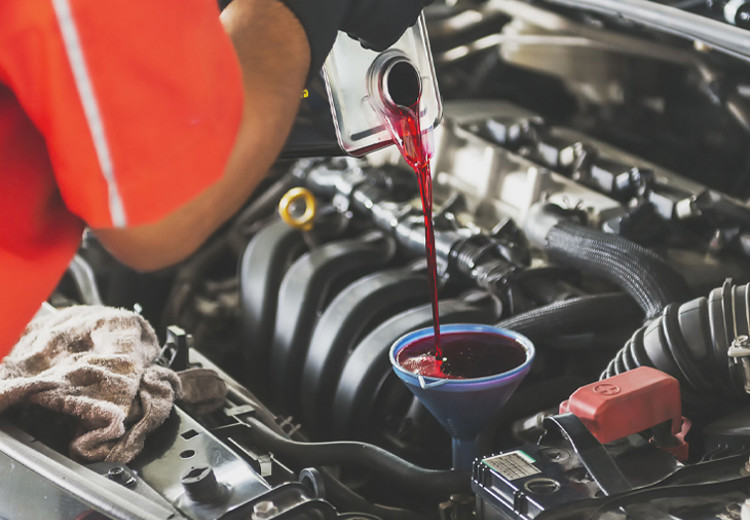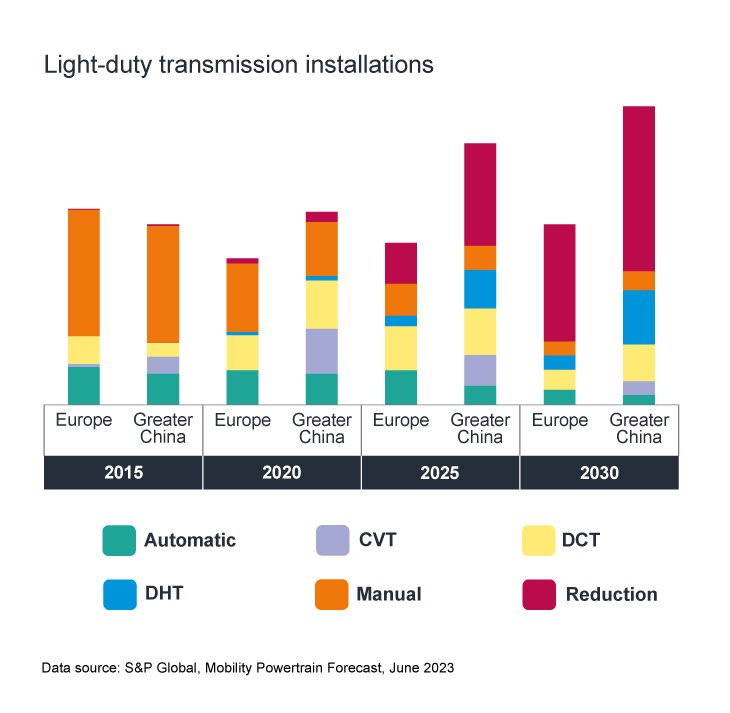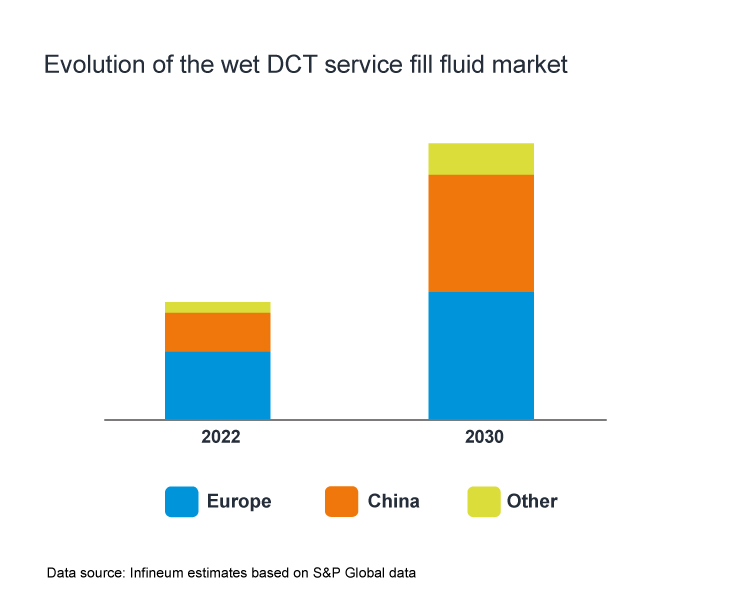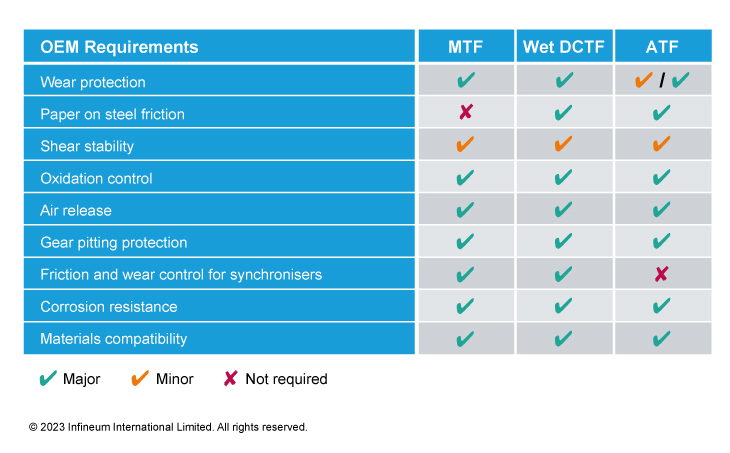Driveline
Balancing efficiency and durability
20 May 2025
05 September 2023
Meeting the diverse requirements of the growing transmissions markets in Europe and China with multi-vehicle service-fill fluids

As OEMs look to improve vehicle efficiency, dual clutch transmissions (DCT) are proving to offer advantages in the previously manual dominated Chinese and European markets. As a result, we are continuing to see significant growth in their use in light-duty vehicles in these regions. Infineum’s Claire Saville and Jeffery Du talk to Insight about these growing markets and how multi-vehicle fluids can help meet not just today’s service fill requirements but also those of the future as these markets continue to evolve.
Light-duty vehicle sales in Europe and China are continuing to grow. And, as emissions and fuel economy legislation tightens in both regions, conventional manual and stepped automatic transmissions are losing ground as OEMs opt for more fuel efficient options. In these two regions, dual clutch transmissions (DCT), which are automatic transmissions that use a manual gearbox architecture with two separate clutches for seamless and fast shifting, are proving to be a good fit. This is mainly owing to the improved efficiency vs. manual and automatic options, the cost advantage of DCT, the ease of converting existing manual transmission production facilities to DCT production and also the ability to meet end user appetite for faster and smoother performance.
Currently, some 20% of new vehicles in Europe and China use a DCT. By 2025, installations in China and Europe are expected to account for over 90% of the world’s more than 10.5 million wet and dry DCT installations.

Looking out beyond 2025, global DCT installations are expected to decline slightly as the use of dedicated hybrid transmissions (DHT) in electrified powertrains increases. However, with a growing vehicle parc, DCTs will be in the vehicles on the road and need servicing for many years to come.
The European Automobile Manufacturers’ Association (ACEA) estimates that there are some 246 million cars on the road in the European Union today and that their average age is almost 12 years. While in China, it is suggested there could be over 319 million cars on the road, with an average age of around 6.4 years, over 40 million of which contain a DCT. These large and growing vehicle parcs mean that the market for DCT service fill fluids in these two regions can be expected to grow up to and well beyond 2030.
The market for dry DCT fluids is relatively small and the requirements here can typically be met with conventional manual transmission fluids (MTF). However, the service fill market for wet DCTs, used in high torque applications, is larger and these systems generally require specifically tailored fluids.

Comparing the fluid requirements of manual, dual clutch and automatic transmissions systems side by side we can see a number of key differences.

Looking specifically at wet DCT fluids (DCTF), along with meeting all the requirements for MTF, they must also provide paper on steel (PoS) friction control for wet clutches, similar to an automatic transmission fluid (ATF). It can be a challenge to add this level of friction performance without negatively impacting the existing characteristics of a MTF. This is because PoS friction additives compete with wear protection additives, and can impact the friction control of the synchronisers, requiring a careful balance. This balance is also what makes DCTFs different from ATFs, as automatic transmissions require less wear protection and do not contain synchronisers.
These growth trends and challenges provide lubricant manufacturers with a real opportunity to market high value fluids specifically designed to meet the requirements of wet DCT systems.
Currently the market is highly fragmented with several automotive manufacturers offering wet DCT technologies. While VW is the clear leader, many other OEMs including Getrag, Punch Powertrain, Mercedes Benz, Geely and Tsingshan are also supplying wet DCTs. Not only are there a large number of market participants but also two distinct designs are being manufactured. The most common has a single sump to lubricate the gears and clutch, while the other has separate sumps for each. This puts a very diverse mix of wet DCT technologies into the servicing pool and creates logistics challenges for service shops.
One multi-vehicle product, with broad approvals capable of meeting the diverse OEM requirements in both conventional internal combustion engine and hybrid vehicles, can simplify service shop logistics and help to avoid misapplication.
Infineum DCT additive technologies already have a broad spectrum of claims in place, which cover the top OEMs’ suitable for use (SFU) requirements. These multi-vehicle options can offer significant advantages to customers looking for a single fluid to cover a range of light-duty applications.
As OEMs work to electrify their powertrains, it is likely that DCTs will be used in full hybrid vehicles. This is a very challenging combination for the transmission fluid, which must meet conventional protection and performance requirements while also offering materials compatibility, particularly for copper, delivering electrical properties and cooling the motor.
Click here to find out more about our 100,000 km field trials that demonstrated the performance and protection delivered by our additives in a range of DCT equipped hybrid vehicles.
In addition, in a future where vehicles will be increasingly electrified, a growth in the use of dedicated hybrid transmissions (DHT) is forecast. Our specialised additives have you covered today – with broad approvals that enable you to meet the service fill requirements of the diverse DCT market. But, we are also looking out to the future and, as the market continues to diversify, our multi-vehicle DCT additives will meet future car servicing needs as the parc moves to hybrids fitted with DHT.
Whatever transmission hardware routes OEMs take to meet their emissions reduction and decarbonisation commitments, Infineum multi-vehicle technologies can help meet the service fill needs of this highly complex market – keeping you covered for longer.
Sign up to receive monthly updates via email